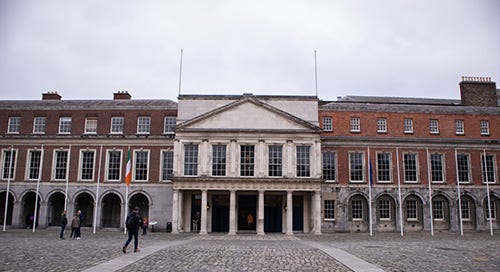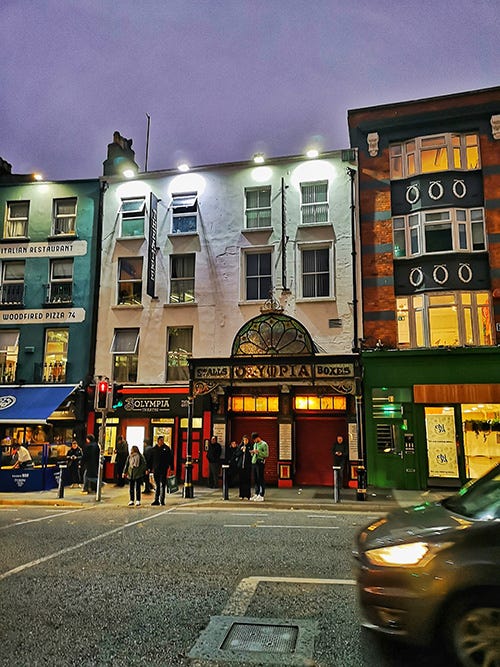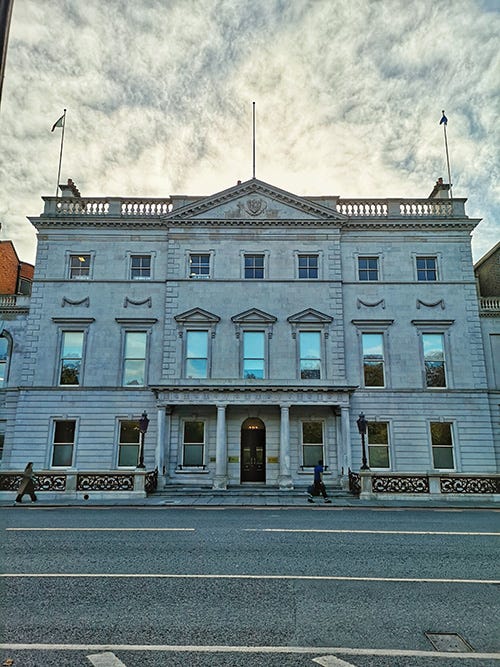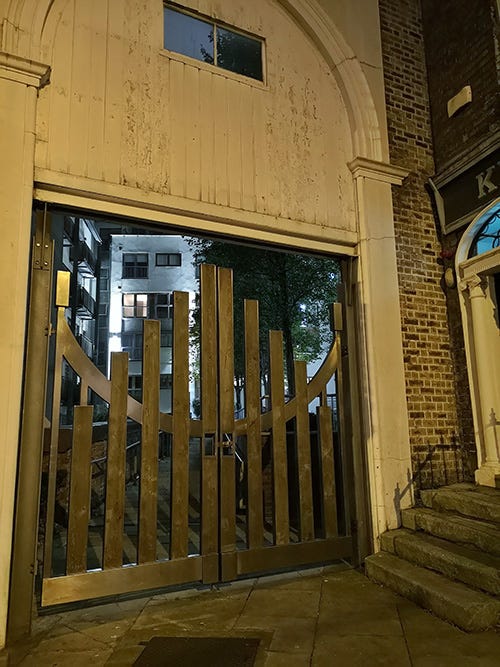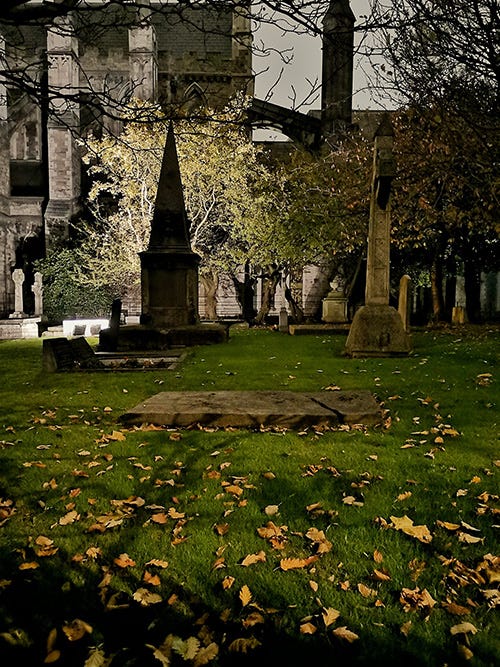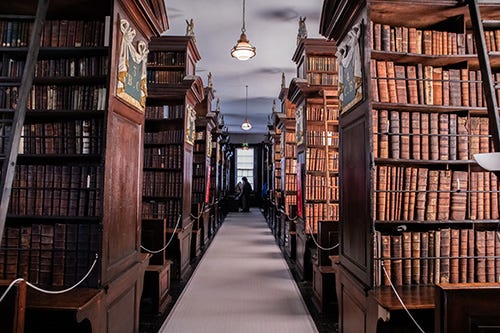Dublin is a beautiful city that straddles the River Liffey, famous as the home of Guinness and the National Leprechaun Museum. What you might not expect from the Irish capital is a series of Dublin ghost stories.
Though why not? The city enjoys a millennium of history, including Viking settlement, economic hardship caused by the Dissolution of the Monasteries, and the fight for independence from Britain. Of course there would be ghost stories!
For much of this article, I followed the legends related by Dave Walsh in Haunted Dublin, though where I could, I did a little digging of my own.
But enough of the preamble. Let’s explore some Dublin ghost stories!
Dublin Castle
Dublin Castle stands on the site of a Viking settlement on Castle Street, and was the seat of English—and then British—rule in Ireland between 1204 and 1922. While it began life as a medieval fortress, it later became more of an administrative centre. The original castle building stood where we now find Upper Castle Yard, though a fire in April 1684 damaged much of the building. Rebuilding work in the 18th century saw the castle become a Georgian palace. You can visit the State Apartments now., which I highly recommend
In 1922, the Viceroy of Ireland vacated the Castle and handed it to the government of the newly-independent Ireland. Interestingly, Bram Stoker worked here between 1866 and 1878 (The Office of Public Works, n.d.).
Naturally, a building like this is bound to attract a spectre or two. A sergeant wrote about his experiences in 1955 in the Garda Review, including a light that turned off by itself when he was alone in the dormitory. If he turned it back on, he found he remained alone.
He also heard coal being shovelled in the kitchen. If he went to investigate, the fire remained cold and unlit, with the coal shovel standing nearby.
According to Walsh, a woman haunts a building in the Upper Castle Yard. It seems she pines for a partner who went to battle and never returned (2008: 43). The Paranormal Database relates a story that sees would-be invaders executed, and their bodies buried within the castle walls. Their ghosts apparently wander the grounds, though there are no further details as to when this happens, or indeed last happened (2025).
The Olympia Theatre
This theatre stands on Dame Street, having first opened in 1879. It has been rebuilt and refurbished since then.
But paranormal researcher Hans Holzer and psychic Sybil Leek investigated some supernatural shenanigans here in 1965. It seems staff were tired of unexplained banging, windows rattling, disembodied footsteps, and the general sensation of ‘someone’ in the building. Someone—or something—kept knocking on the door of dressing room no.9. No one was ever in the corridor when the occupant opened the door (Walsh 2008: 43).
A stage manager described seeing a yellow light drift at knee height along the corridor towards that same dressing room. He tried to follow it but a door closed in his face. Meanwhile, an electrician reported the rostrum he was sitting on moving while he remained sat on it (Walsh 2008: 44).
Holzer deliberately kept Leek out of the interview process, and once he’d spoken to the staff, asked Leek for her impressions. She felt a young man was trapped in the theatre. He’d been caught up in a violent incident in the theatre, although the Olympia itself was simply the location, rather than being important to the story. Holzer went back to the staff with this new information, and a stagehand confirmed that someone chased a civilian into the theatre during the 1916 Rising and shot him (Walsh 2008: 44).
The Shelbourne Hotel
Holzer and Leek appear in another tale of hauntings, this time in the Shelbourne Hotel, on the corner of St Stephen’s Green. It opened in 1824 after Martin Burke converted a row of townhouses into a hotel. Interestingly, hotel management explained they’d had no reports of ghosts in the building until Leek arrived and announced her room was haunted (Walsh 2008: 60).
While in bed, at around 2:20 am, she heard crying in the room. She asked whoever it was if something was wrong, and a voice replied they were frightened. Surprisingly, Leek invited the presence onto the bed, and she described the weight of a child climbing up beside her. She felt a child’s arm around her neck, and Leek fell asleep.
The following night, she was joined by the presence of a young girl who called herself Mary Masters. Leek invited Holzer and his wife to join her for a trance session the next night. Unfortunately, the conversation was disjointed and unhelpful. The tale ends there, because there were no reports before or after Holzer and Leek’s stay there (Walsh 2008: 61).
Or were there? Walsh’s book is from 2008, while the Paranormal Database say that guests fled a particular room in fear in 2015 (2025).
Here’s the thing though. It couldn’t be the same room because the hotel was gutted and rebuilt behind the original facade, so Leek’s haunted room no longer exists…
Iveagh House
Iveagh House, on St Stephen’s Green, houses the Department of Foreign Affairs. Yet years ago, a legend clung to the building that a servant girl once lay dying in her room when the house belonged to the Guinness family. The household was Protestant but the girl was Catholic and they denied her a priest.
According to the story, they’d thrown her rosary beads out of the window. This might explain why crowds gathered to see a cross appear on one of the panes of glass on Holy Thursday (Walsh 2008: 61).
Walsh explains the legend might be linked to the earlier houses converted into a single building in 1862.
Fishamble Street Theatre
The Fishamble Street Theatre no longer stands, replaced by a housing development. Interestingly, the street name was originally Fish Shambles, indicating the sale of fish in the area (Flood 1912: 51).
Also known as Mr Neale’s Music Hall, it opened in 1741. The venue could hold 700 people, making it Ireland’s largest concert venue (Bardon 2015: 18). One of its claims to fame is being the venue for the premiere of Handel’s Messiah on 13 April 1742. The money raised by the event went to Mercer’s Hospital.
In the mid-nineteenth century, the theatre needed a few repairs. John Hogan, an apprentice builder, worked on the theatre during the day and slept in the Green Room at night. At 10 pm every night, knocking would start in the building and continue for fifteen minutes. Hogan asked to sleep somewhere else, but the request was denied. He simply slept with the blankets pulled tightly over his head.
No one knows who – or what – made the knocks. Yet they continued until the theatre was demolished sixty years later (Walsh 2008: 45). I’d be fascinated to know if any phenomena continues in the housing in the area!
St Patrick’s Cathedral
I’ve featured many a spectral dog on this blog, but none seem quite so approachable as the ghostly Newfoundland at St Patrick’s Cathedral. He’s believed to haunt John McNeill Boyd’s grave after Boyd, the captain of the HMS Ajax, was lost at sea in 1861. He and fourteen of his crew were swept out to sea while trying to rescue the crew of another ship during a storm. One legend sees his Newfoundland in the rescue boat, though they seemingly found no survivors.
The dog apparently accompanied Boyd’s body back to Dublin and refused to leave his grave, and sadly, starved to death (Walsh 2008: 52). He’s been seen loitering near the grave. There’s also a statue of Boyd inside the cathedral. Former Dean David Wilson reported sightings of the dog near this statue.
Walsh notes that there are sources that insist Boyd was buried in Glasnevin Cemetery. These sources suggest a ghostly dog seen in that cemetery was Boyd’s faithful hound. Yet Walsh has visited Boyd’s grave at St Patrick’s Cathedral to confirm that’s where he is buried (2008: 51).
I visited St Patrick’s Cathedral, and sadly saw no sign of a spectral dog inside the church. There was no access to the churchyard, although I did peer through the railings during a ghost walk on Halloween. Boyd’s loyal dog chose not to make an appearance then, either.
A different legend attached to the churchyard claims a wealthy woman was buried in the family mausoleum wearing her most expensive jewellery. Someone (it varies as to who it is) broke into the tomb to steal it. While robbing the body, the thief realised they couldn’t get a ring off her finger. When he tried to sever her finger to free the ring, it woke the woman from the cataleptic fit into which she’d fallen. She seemingly rose from the dead and returned home.
I’ve also heard this story associated with the City of London, York, and Edinburgh. It’s nice to know Dublin has its own variation on the Premature Burial urban legend.
Marsh’s Library
You’ll find Marsh’s Library just around the corner from St Patrick’s Cathedral, and it was quite possibly my favourite part of Dublin. Archbishop Narcissus Marsh founded the library in 1701 as Ireland’s first public library. Its collection covers the 16th-18th centuries, and a huge range of subjects including medicine, music, mathematics, and literature. I cannot recommend a visit enough.
But you’re here for ghosts. According to one legend, a ghost drifts around the library, combing through the books. People believe this is Marsh himself, who was the guardian of his niece, Grace. Working as his housekeeper wasn’t exactly exciting, so it’s hardly surprising she fell for a sea captain. Marsh tried to part them but they eloped. The story explains that Grace left a note in one of the books, begging for foregiveness, but she left no clue as to which book it was (Walsh 2008: 53). Marsh never managed to find it and now spends eternity looking for it.
Others think Charles Maturin, author of Melmoth the Wanderer, is the library ghosts because he spent so long working in the library. Others think it’s Jonathan Swift, author of Gulliver’s Travels, who was Dean of St Patrick’s Cathedral.
Yet Swift also apparently haunts the Deanery, across St Patrick’s Close. Dean Griffin and his wife, who moved into the house in the 1960s reported a benevolent presence in the building that often kept them company when they were alone (Walsh 2008: 56). Dean Griffin reported seeing a man ascending the stairs and going into a bedroom. He thought it was his brother-in-law, who was a guest at the time. But when he called goodnight, no one replied. When Dean Griffin went to check on his brother-in-law, he found the room empty. The same thing happened at the same hour six months later, and Dean Griffin searched the house. His wife was apparently less perturbed, telling him not to worry (Walsh 2008: 57).
What do we make of these Dublin ghost stories?
As always, when we look at these European City ghost stories, we have to remember that cities concentrate history in a particular way. With that many people in the same space at the same time, incidents play out in a more impactful way.
Plus, having lots of people living alongside each other on the same site for centuries will create all sorts of energetic signatures. Is it possible that visitors to these cities ‘set off’ these signatures when they interact with them, even unwittingly?
What’s your favourite of these Dublin ghost stories? Let me know!
References
Bardon, Jonathan (2015), Hallelujah: The Story of a Musical Genius and the City that Brought His Masterpiece to Life, Dublin: Gill & Macmillan.
Flood, W. H. Grattan (1912), ‘Fishamble St. Music Hall, Dublin, from 1741 to 1777’, Sammelbände der Internationalen Musikgesellschaft, 14 (1), pp. 51-57.
Office of Public Works (no date), ‘History’, Dublin Castle, https://dublincastle.ie/history/. Accessed 9 July 2025.
Paranormal Database (2025), ‘Dublin Ghosts, Folklore and Forteana’, The Paranormal Database, https://www.paranormaldatabase.com/hotspots/dublin.php. Accessed 9 July 2025.
Walsh, Dave (2008), Haunted Dublin, Dublin: The History Press.


